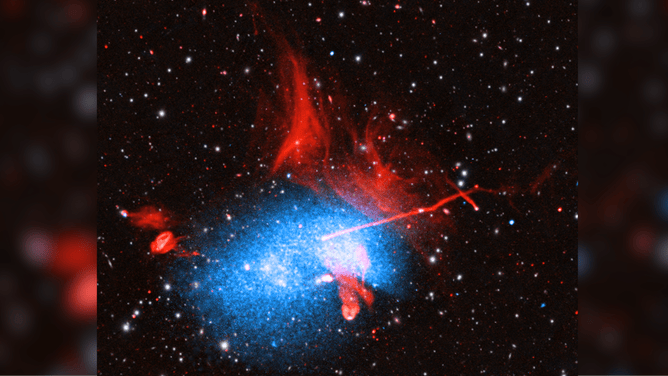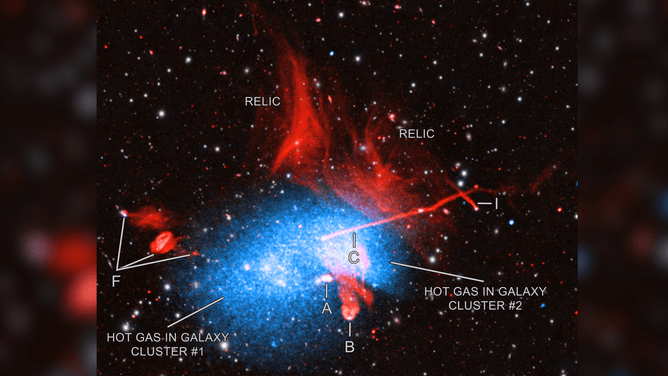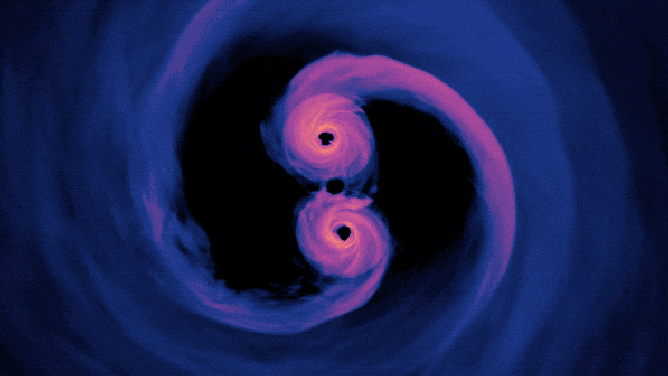New image shows galaxies colliding, forming a giant galaxy cluster
Collisions like this are the main way larger galaxies, such as the Milky Way, form. The giant galaxy cluster being formed by this merger is called Abell 2256.
Telescopes: Answering questions for centuries
Telescopes have helped humans to see a universe beyond our world and to find ways to explore it.
NASA released an image Monday showing the merger of at least three galaxy clusters 780 million light-years away.
A galaxy cluster is a collection of hundreds or thousands of individual galaxies. They are some of the largest objects in the universe.
'BURIED TREASURE': JAMES WEBB TELESCOPE'S NEWEST IMAGES SHOW STAR AT BIRTH
The collision of galaxy clusters, similar to the three captured in the new image, is the primary way for the formation of gigantic galaxies, such as the Milky Way.
Before they can create a Milky Way-sized galaxy, the smaller three galaxy clusters are colliding to form a giant galaxy cluster called Abell 2256.
Creating an image of the collision

Galaxies colliding to form the giant galaxy cluster Abell 2256.
(X-ray: Chandra: NASA / CXC / Univ. of Bolonga / K. Rajpurohit et al.; XMM-Newton: ESA / XMM-Newton / Univ. of Bolonga / K. Rajpurohit et al. Radio: LOFAR: LOFAR / ASTRON; GMRT: NCRA / TIFR / GMRT; VLA: NSF / NRAO / VLA; Optical / IR: Pan-STARRS / NASA)
The false color image of this collision contains what appear to be coral red flames flirting with a light blue cloud, all set upon the backdrop of speckles of white and pale yellow.
According to NASA, this scene is a composite image combining different types of data collected by a number of observatories and radio telescopes:
- Blue "cloud" - X-rays detected by NASA’s Chandra X-ray Observatory and by the European Space Agency’s XMM-Newton observatory.
- Red "flames" - Radio data collected by India's Giant Metrewave Radio Telescope, Europe's Low Frequency Array and the Karl G. Jansky Very Large Array in New Mexico.
- White and pale yellow - Optical and infrared data collected by Pan-STARRs telescope in Hawaii.
HOW TELESCOPES BECAME OUR WINDOW INTO THE UNIVERSE
Where the X-rays and radio emissions are coming from

Label show the different components and types of data collected from the collision.
(X-ray: Chandra: NASA / CXC / Univ. of Bolonga / K. Rajpurohit et al.; XMM-Newton: ESA / XMM-Newton / Univ. of Bolonga / K. Rajpurohit et al. Radio: LOFAR: LOFAR / ASTRON; GMRT: NCRA / TIFR / GMRT; VLA: NSF / NRAO / VLA; Optical / IR: Pan-STARRS / NASA)
The X-rays that appear as a blue cloud in the formation of Abell 2256 indicate large reservoirs of gas with temperatures of several million degrees.
Radio emissions, on the other hand, come from a number of sources.
One source is the galaxies within the clusters, as the supermassive black holes at their centers are erupting streams of particles into space. These streams generate radio signals.
WHAT IS A BLACK HOLE? HERE'S WHY THESE ENIGMAS OF SPACE DON'T SUCK
The collision and merger of the three galaxy clusters is also triggering the growth of more particle- and radio-emitting supermassive black holes. This may be why Abell 2256 has an "unusually" large number of galaxies producing radio waves, NASA said.

Gas glows brightly in this computer simulation of supermassive black holes only 40 orbits from merging. Models like this may eventually help scientists pinpoint real examples of these powerful binary systems.
(NASA’s Goddard Space Flight Center / Scott Noble / NASA)
Another source of radio emissions are coming from "relics." According to NASA, relics are huge filamentary structures that formed when the collision of galaxy clusters produced shock waves and accelerated particles in the gas over two million light-years.
In fact, galaxy collisions such as the one captured in the image act as the largest particle accelerators in the universe. Particle accelerators ramp up the speed of subatomic particles, such as electrons and protons, to form new particles.
Radio emissions could also be detected at the center of the collision. These emissions may be caused by the reacceleration of particles, which may be produced by the rapid changes in the temperature and density of gas during the galaxy cluster collision.
Radio, X-ray and other data from the telescopes will continue to be studied.
